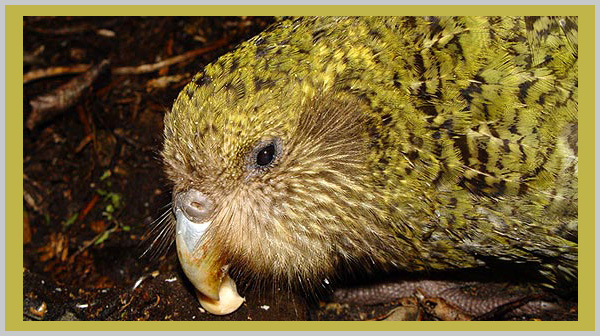
Kakapo
Name: Kakapo (Strigops habroptila)
Conservation Status: Critically Endangered (2021 IUCN Red List)
Wild Population Estimate: 149
Range: New Zealand
Threats: Invasive Species / Diseases
The kakapo is also called the “owl parrot” for its nocturnal habits and owllike body and large eyes. There once were hundreds of thousands of kakapos on the islands of New Zealand in the south Pacific. Today only about 149 kakapos survive in the wild on two small islands off the coast of New Zealand’s South Island.
Natural History
An almost flightless parrot, the kakapo is an extremely fat bird. Adults can weigh 6 or 7 pounds (3 kg). The kakapo is ground-dwelling, but it will sometimes climb trees. With its large parrot-bill, a kakapo eats nuts, seeds, fruits, vegetation, and some insects.
Kakapos are otherwise solitary birds, but they have a very elaborate mating system. The male builds a “bowl,” a shallow depression in the ground with paths leading to it through the underbrush. He sits in the bowl and “booms” to attract females: he repeatedly sends out a deep, resonant call that can be heard over great distances.
One researcher said that the call was so low was felt more in the bones than it was heard, “like a heartbeat in the night”. To complicate matters, females apparently come into breeding condition only when a particular tree fruits, which is just once every two years or so. Then the female lays a single egg in a nest on the ground.
Causes of Endangerment
Hunting and Introduced Species
The uniqueness and limited geographical ranges of island species make them particularly vulnerable to extinction (see Spotlight on Island Biogeography).
Until relatively recently, there were no human settlements on the isolated islands of New Zealand. There were no snakes or mammals or other predators to eat the native birds or their eggs.
The birds of New Zealand did not need the ability to fly, since life was easy with no predators. Flying is hard work and consumes a lot of energy, so over thousands of years, many of New Zealand’s birds lost the ability to fly. Other flightless birds include the now-extinct moa and the national symbol of New Zealand, the kiwi.
These defenseless birds were an easy food source for the first humans, ancestors of the New Zealand Maoris, and later European settlers. People brought with them a host of predators: dogs, cats, weasels, possums, and rats. The ground-nesting birds were defenseless. These introduced predators made easy meals of birds and eggs alike (see similar effects of introduced species in Case Studies on the Blue Pike and the Numbat).
Like several other birds unique to New Zealand, the kakapo has been extirpated throughout most of its range due to habitat destruction and predation. Its slow reproduction rate and elaborate mating system, which probably served as a useful natural population control when there were no predators, have only sped its demise.
Conservation Actions
Habitat Protection
New Zealand faces major challenges to conserve its many endangered plants and animals. Today about 30 percent of the country’s land is under the care of New Zealand’s Department of Conservation, which manages national parks and other protected areas. The Department is placing emphasis on protection of habitats, rather than captive breeding programs.
Relocation to Reserves
New Zealand has undertaken an intensive relocation and protection program to save the kakapo. Any kakapos surviving on inhabited islands of New Zealand are carefully trapped and relocated to protected refuge islands where all predators such as feral cats and rats have been eliminated. Caretakers live on the island and human access is strictly controlled. No boats are allowed to land, for fear that rats will be brought ashore.
Questions for Thought
Little is known about the kakapo’s role in its native habitat. What role(s) do you think this bird might have played? What might change on the larger islands of New Zealand now that the kakapo is gone? (see Case Study on The Dodo Bird)
Rescuing and relocating the kakapo has been an expensive project for the New Zealand government. Do you think this much effort is warranted for one bird species?
The refuge islands where kakapos survive today are also home to a large number of other endangered plants and animals. What value might there be in saving this native “snapshot” of New Zealand flora and fauna?
Explore:
Related Classroom Activities:
[CS1-1,CS1-3,General]
Click here for Endangered Species Classroom Glossary